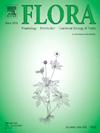Pappus morphology and heterocarpy in Stevia (Eupatorieae, Asteraceae): A systematic study of cypselae diversity and geographic distribution
IF 1.7
4区 生物学
Q3 ECOLOGY
引用次数: 0
Abstract
The genus Stevia (Asteraceae, Eupatorieae) is widely distributed across the Americas and exhibits remarkable diversity in cypsela morphology and pappus structure. The variation in pappus types, including both homocarpic and heterocarpic species, plays a critical role in species delimitation within the genus. In this study, we investigate the morphology of cypselae and pappus across a diverse sample of Stevia species, emphasizing the systematic significance of pappus variation. Species were analyzed using light and scanning electron microscopy, focusing on key traits such as pappus structure, the presence of heterocarpy, and the arrangement of cypselae within the capitulum. Eight distinct pappus types were identified and described as fundamental morphological patterns. Additionally, species distribution maps are provided to illustrate the geographical patterns associated with these pappus types. Our findings contribute to a deeper understanding of morphological diversity within Stevia and underscore the importance of pappus variation in species identification and taxonomic classification.
求助全文
约1分钟内获得全文
求助全文
来源期刊

Flora
生物-植物科学
CiteScore
3.30
自引率
10.50%
发文量
130
审稿时长
54 days
期刊介绍:
FLORA publishes original contributions and review articles on plant structure (morphology and anatomy), plant distribution (incl. phylogeography) and plant functional ecology (ecophysiology, population ecology and population genetics, organismic interactions, community ecology, ecosystem ecology). Manuscripts (both original and review articles) on a single topic can be compiled in Special Issues, for which suggestions are welcome.
FLORA, the scientific botanical journal with the longest uninterrupted publication sequence (since 1818), considers manuscripts in the above areas which appeal a broad scientific and international readership. Manuscripts focused on floristics and vegetation science will only be considered if they exceed the pure descriptive approach and have relevance for interpreting plant morphology, distribution or ecology. Manuscripts whose content is restricted to purely systematic and nomenclature matters, to geobotanical aspects of only local interest, to pure applications in agri-, horti- or silviculture and pharmacology, and experimental studies dealing exclusively with investigations at the cellular and subcellular level will not be accepted. Manuscripts dealing with comparative and evolutionary aspects of morphology, anatomy and development are welcome.
 求助内容:
求助内容: 应助结果提醒方式:
应助结果提醒方式:


